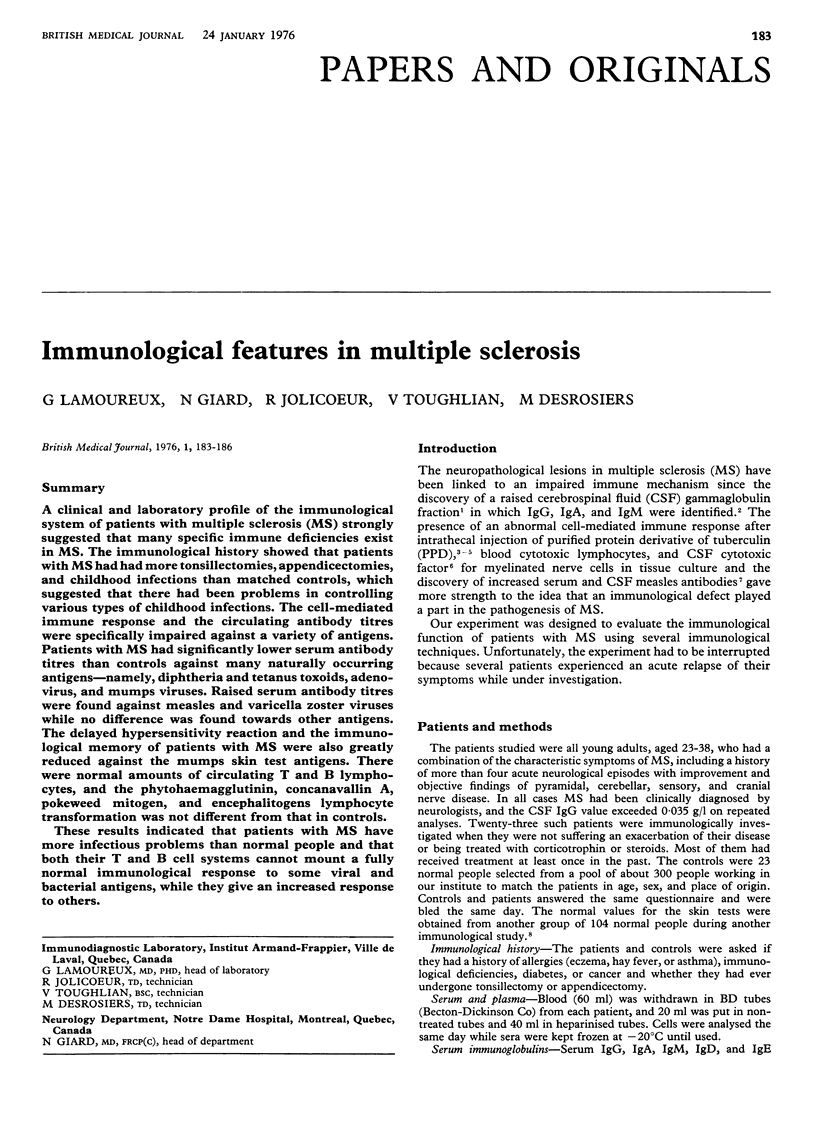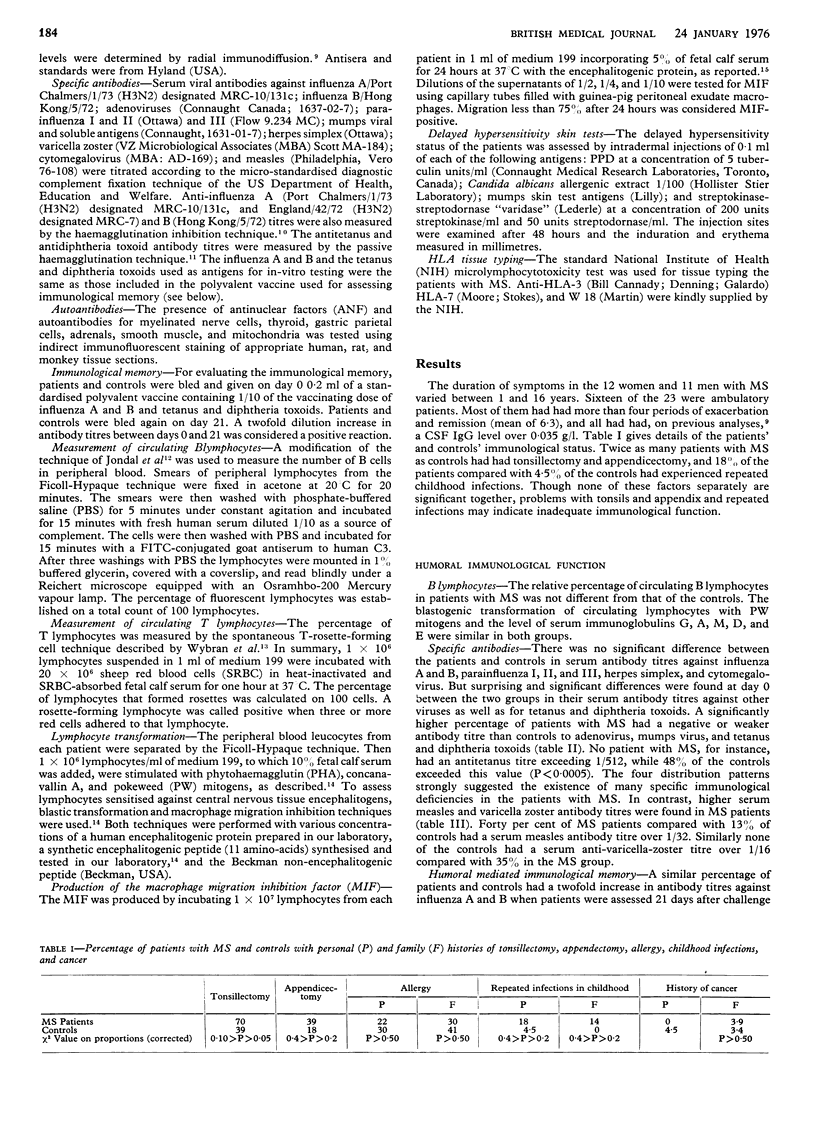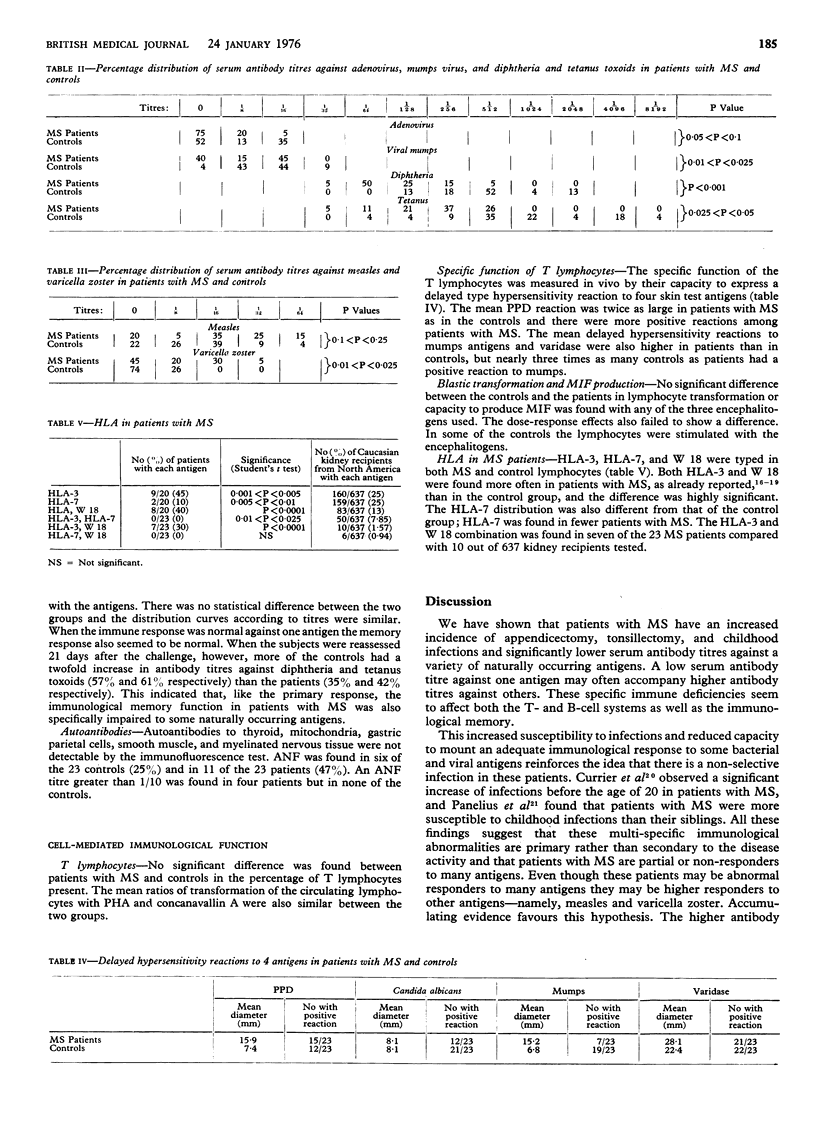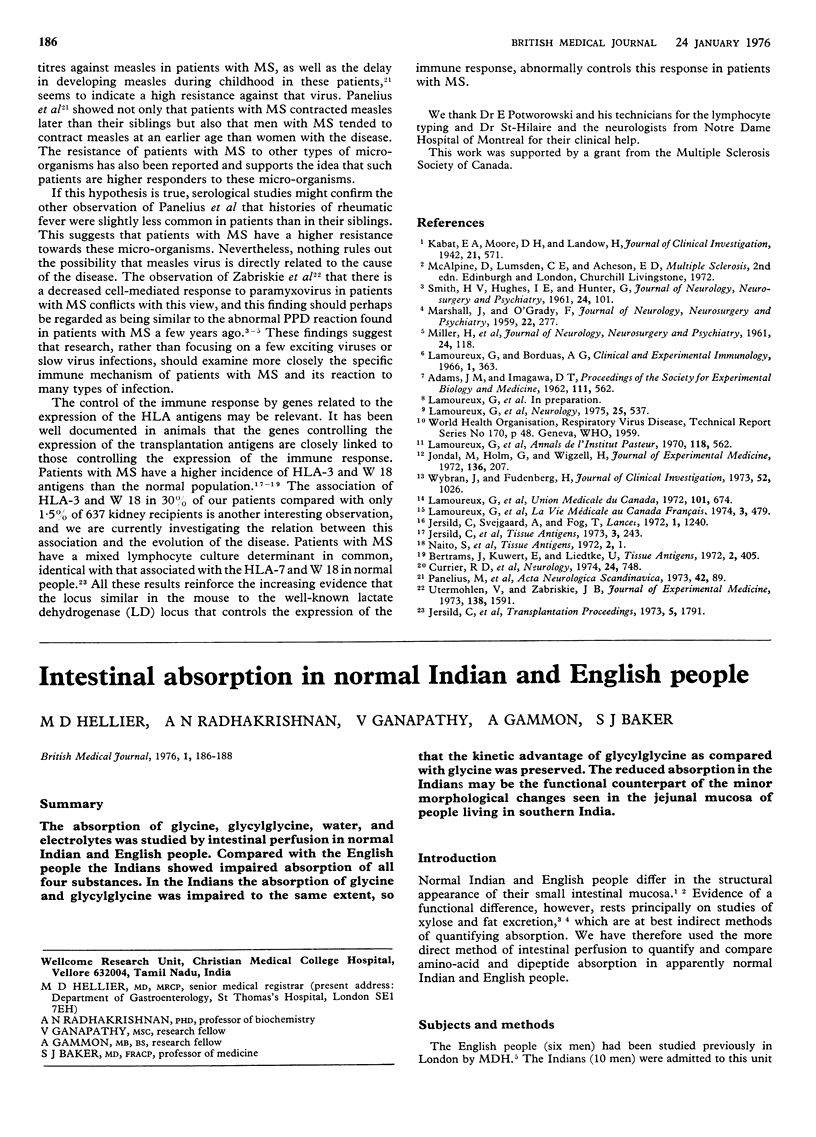Abstract
A clinical and laboratory profile of the immunological system of patients with multiple sclerosis (MS) strongly suggested that many specific immune deficiencies exist in MS. The immunological history showed that patients with MS had had more tonsillectomies, appendicectomies, and childhood infections than matched controls, which suggested that there had been problems in controlling various types of childhood infections. The cell-mediated immune response and the circulating antibody titres were specifically impaired against a variety of antigens. Patients with MS had significantly lower serum antibody titres than controls against many naturally occurring antigens-namely, diptheria and tetanus toxoids, adenovirus, and mumps viruses. Raised serum antibody titres were found against measles and varicella zoster viruses while no difference was found towards other antigens. The delayed hypersensitivity reaction and the immunological memory of patients with MS were also greatly reduced against the mumps skin test antigens. There were normal amounts of circulating T and B lymphocytes, and the phytohaemagglutinin, concanavallin A, pokeweed mitogen, and encephalitogens lymphocyte transformation was not different from that in controls. These results indicated that patients with MS have more infectious problems than normal people and that both their T and B cell systems cannot mount a fully normal immunological response to some viral and bacterial antigens, while they give an increased response to others.
Full text
PDF



Selected References
These references are in PubMed. This may not be the complete list of references from this article.
- ADAMS J. M., IMAGAWA D. T. Measles antibodies in multiple sclerosis. Proc Soc Exp Biol Med. 1962 Dec;111:562–566. doi: 10.3181/00379727-111-27855. [DOI] [PubMed] [Google Scholar]
- Bertrams J., Kuwert E., Liedtke U. HL-A antigens and multiple sclerosis. Tissue Antigens. 1972;2(5):405–408. doi: 10.1111/j.1399-0039.1972.tb00060.x. [DOI] [PubMed] [Google Scholar]
- Currier R. D., Martin E. A., Woosley P. C. Prior events in multiple sclerosis. Neurology. 1974 Aug;24(8):748–754. doi: 10.1212/wnl.24.8.748. [DOI] [PubMed] [Google Scholar]
- Jersild C., Dupont B., Fog T., Hansen G. S., Nielsen L. S., Thomsen M., Svejgaard A. Histocompatibility-linked immune-response determinants in multiple sclerosis. Transplant Proc. 1973 Dec;5(4):1791–1796. [PubMed] [Google Scholar]
- Jersild C., Svejgaard A., Fog T., Ammitzboll T. HL-A antigens and diseases. I. Multiple sclerosis. Tissue Antigens. 1973;3(4):243–250. doi: 10.1111/j.1399-0039.1973.tb01002.x. [DOI] [PubMed] [Google Scholar]
- Jersild C., Svejgaard A., Fog T. HL-A antigens and multiple sclerosis. Lancet. 1972 Jun 3;1(7762):1240–1241. doi: 10.1016/s0140-6736(72)90962-2. [DOI] [PubMed] [Google Scholar]
- Jondal M., Holm G., Wigzell H. Surface markers on human T and B lymphocytes. I. A large population of lymphocytes forming nonimmune rosettes with sheep red blood cells. J Exp Med. 1972 Aug 1;136(2):207–215. doi: 10.1084/jem.136.2.207. [DOI] [PMC free article] [PubMed] [Google Scholar]
- Kabat E. A., Moore D. H., Landow H. AN ELECTROPHORETIC STUDY OF THE PROTEIN COMPONENTS IN CEREBROSPINAL FLUID AND THEIR RELATIONSHIP TO THE SERUM PROTEINS. J Clin Invest. 1942 Sep;21(5):571–577. doi: 10.1172/JCI101335. [DOI] [PMC free article] [PubMed] [Google Scholar]
- Lamoureux G., Borduas A. G. Immune studies in multiple sclerosis. Clin Exp Immunol. 1966 Oct;1(4):363–376. [PMC free article] [PubMed] [Google Scholar]
- Lamoureux G., Jolicoeur R., Giard N., St-Hilaire M., Duplantis F. Cerebrospinal fluid proteins in multiple sclerosis. Neurology. 1975 Jun;25(6):537–546. doi: 10.1212/wnl.25.6.537. [DOI] [PubMed] [Google Scholar]
- Lamoureux G., Thibeault G., Richer G., Bernard C. Induction de l'encéphalite allergique expérimentale avec des encéphalitogènes humains de synthèse. Union Med Can. 1972 Apr;101(4):674–680. [PubMed] [Google Scholar]
- MARSHALL J., O'GRADY F. The non-specificity of the intrathecal reaction to tuberculin in multiple sclerosis. J Neurol Neurosurg Psychiatry. 1959 Nov;22:277–284. doi: 10.1136/jnnp.22.4.277. [DOI] [PMC free article] [PubMed] [Google Scholar]
- Naito S., Namerow N., Mickey M. R., Terasaki P. I. Multiple sclerosis: association with HL-A3. Tissue Antigens. 1972;2(1):1–4. doi: 10.1111/j.1399-0039.1972.tb00111.x. [DOI] [PubMed] [Google Scholar]
- Utermohlen V., Zabriskie J. B. A suppression of cellular immunity in patients with multiple sclerosis. J Exp Med. 1973 Dec 1;138(6):1591–1596. doi: 10.1084/jem.138.6.1591. [DOI] [PMC free article] [PubMed] [Google Scholar]
- Wybran J., Fudenberg H. H. Thymus-derived rosette-forming cells in various human disease states: cancer, lymphoma, bacterial and viral infections, and other diseases. J Clin Invest. 1973 May;52(5):1026–1032. doi: 10.1172/JCI107267. [DOI] [PMC free article] [PubMed] [Google Scholar]


